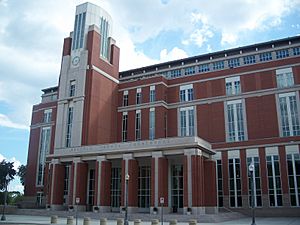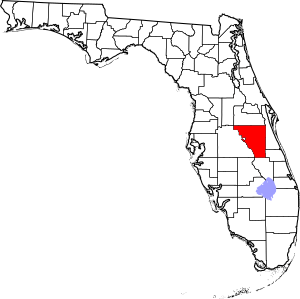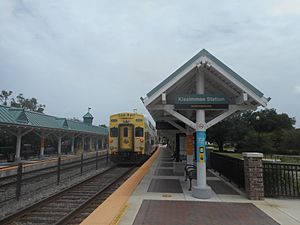Osceola County, Florida facts for kids
Quick facts for kids
Osceola County
|
|||||
|---|---|---|---|---|---|

The Osceola County Courthouse in October 2009
|
|||||
|
|||||

Location within the U.S. state of Florida
|
|||||
 Florida's location within the U.S. |
|||||
| Country | |||||
| State | |||||
| Founded | May 12, 1887 | ||||
| Named for | Osceola | ||||
| Seat | Kissimmee | ||||
| Largest city | Kissimmee | ||||
| Area | |||||
| • Total | 1,506 sq mi (3,900 km2) | ||||
| • Land | 1,327 sq mi (3,440 km2) | ||||
| • Water | 178 sq mi (460 km2) 11.9% | ||||
| Population
(2020)
|
|||||
| • Total | 388,656 | ||||
| • Density | 293/sq mi (113.1/km2) | ||||
| Time zone | UTC−5 (Eastern) | ||||
| • Summer (DST) | UTC−4 (EDT) | ||||
| Congressional district | 9th | ||||
Osceola County is a county located in the central part of Florida. In 2020, about 388,656 people lived here. Its main city and county seat is Kissimmee.
Osceola County is part of the larger Orlando area. More than half of the people living here are Hispanic. This makes it one of the few counties in Florida with a Hispanic majority. Many people here are of Puerto Rican background.
Contents
What's in a Name?
Osceola County is named after a famous Native American leader named Osceola. His name means "Black Drink Cry."
A Look Back in Time
Osceola County was created in 1887. It was formed from parts of two other counties: Orange County and Brevard County.
For a while, Osceola County stretched all the way down to Lake Okeechobee. But in 1917, Okeechobee County was formed, making Osceola County smaller.
Since the late 1900s, many people have moved to Osceola County from Puerto Rico. In fact, in the year 2000, Puerto Ricans were the largest group of people reporting their ancestry here.
Where is Osceola County?

Osceola County covers about 1,506 square miles. Most of this area is land, but about 178 square miles (11.9%) is water. The largest lake in the county is Lake Tohopekaliga.
Neighboring Counties
Osceola County shares borders with several other counties:
- Orange County to the north
- Brevard County to the northeast
- Indian River County to the east
- Okeechobee County to the southeast
- Highlands County to the south
- Polk County to the west
- Lake County to the northwest
Getting Around
Trains
A train line runs through the northern part of Osceola County. This line is used by Amtrak for long-distance trips. It is also used by SunRail, which is a commuter train service. SunRail has stops in Kissimmee and Poinciana.
Airports
The main airport in the county is Kissimmee Gateway Airport.
Main Roads
Many important roads pass through Osceola County:
 Interstate 4
Interstate 4 Florida's Turnpike
Florida's Turnpike State Road 417
State Road 417 State Road 429
State Road 429 Osceola Parkway
Osceola Parkway US 441
US 441 /
/ US 17/92
US 17/92 US 192
US 192 CR 15
CR 15 SR 60
SR 60- John Young Parkway
Who Lives Here?
| Historical population | |||
|---|---|---|---|
| Census | Pop. | %± | |
| 1890 | 3,133 | — | |
| 1900 | 3,444 | 9.9% | |
| 1910 | 5,507 | 59.9% | |
| 1920 | 7,195 | 30.7% | |
| 1930 | 10,699 | 48.7% | |
| 1940 | 10,119 | −5.4% | |
| 1950 | 11,406 | 12.7% | |
| 1960 | 19,029 | 66.8% | |
| 1970 | 25,267 | 32.8% | |
| 1980 | 49,287 | 95.1% | |
| 1990 | 107,728 | 118.6% | |
| 2000 | 172,493 | 60.1% | |
| 2010 | 268,685 | 55.8% | |
| 2020 | 388,656 | 44.7% | |
| 2023 (est.) | 437,784 | 62.9% | |
| U.S. Decennial Census 1790-1960 1900-1990 |
|||
The population of Osceola County has grown a lot over the years. In 2020, there were 388,656 people living here.
| Race | Number of People (2020) | Percentage (2020) |
|---|---|---|
| White (not Hispanic) | 113,362 | 29.17% |
| Black or African American (not Hispanic) | 35,145 | 9.04% |
| Native American (not Hispanic) | 562 | 0.14% |
| Asian (not Hispanic) | 11,370 | 2.93% |
| Pacific Islander (not Hispanic) | 240 | 0.06% |
| Some Other Race (not Hispanic) | 4,218 | 1.09% |
| Mixed/Multi-Racial (not Hispanic) | 12,670 | 3.26% |
| Hispanic or Latino | 211,089 | 54.31% |
| Total | 388,656 |
In 2020, over half of the people in Osceola County were Hispanic or Latino. Many of them are from Puerto Rico, making up about 33.7% of the total population.
About 38% of the county's population belongs to a religious group. The largest group is Catholic, followed by other Christian faiths.
The average household in Osceola County has about 3.4 people. The median age of people living here is 36 years old.
Learning and Libraries
The School District of Osceola County, Florida manages the public schools. There are 59 schools in the county, not including colleges.
Colleges in Osceola County
- Johnson University Florida
- Florida Technical College
- Heritage University & Seminary
- Stetson University
- Valencia College - Osceola Campus & Poinciana Campus
Libraries for Everyone
Osceola County has six library branches:
- Buenaventura Lakes Library - Kissimmee, FL
- Hart Memorial Library - Kissimmee, FL
- Kenansville Library - Kenansville, FL
- Poinciana Library - Kissimmee, FL
- St. Cloud Veterans Memorial Library - St. Cloud, FL
- West Osceola Library - Celebration, FL
The Hart Memorial Library is the main library. It has a special "creative space" called TechCentral.
Library History
Before 1989, Osceola County didn't have its own library system. People used the Orange County Library System. Before that, two libraries, Hart Memorial and Veteran's Memorial, were run by women's groups.
In 1910, land for the Hart Memorial Library was given by Carrie S. Hart. In 1914, women raised money to build it. Annie Palmer Fell donated books and furniture. The library moved to a bigger building in 1968. Today, the Hart Memorial Library is very large, at 43,000 square feet.
The Veteran's Memorial Library started as a reading room. It moved to a new building in the 1970s. In 1995, it moved to its current, larger location.
The first Poinciana Branch opened in 1988. It started with 14,000 books. Later, it moved to a larger place with 40,000 books and computers.
The Osceola Library System became its own organization on April 1, 1989. The Buenaventura Library opened in 1990. The Kenansville Branch Library opened in 1991. It was rebuilt in 2007 after hurricanes damaged it in 2004.
Towns and Areas
Cities
Other Communities (Census-designated places)
Smaller Unincorporated Communities
- Bull Creek
- Deer Park
- Harmony
- Holopaw
- Kenansville
- Narcoossee
- Whittier
Future Plans (Destiny)
Years ago, there were plans to build a new city called Destiny. It was going to be near the Florida Turnpike and US 441. However, the plans were stopped because of worries about too much development. The area is now a nature reserve. If it had been built, Destiny was expected to have 250,000 people.
See also
 In Spanish: Condado de Osceola (Florida) para niños
In Spanish: Condado de Osceola (Florida) para niños





